You searched for: 5G基站源码系统快速搭建【TG���������@EK7676】平台包网搭建5G基站源码系统快速搭建【TG���������@EK7676】平台包网搭建13mqZeuPGv
<< Previous | Displaying results 201-250 of 426 for "5G基站源码系统快速搭建【TG���������@EK7676】平台包网搭建5G基站源码系统快速搭建【TG���������@EK7676】平台包网搭建13mqZeuPGv" | Next >>
-
Hajj Amin al-Husayni: Key Dates
ArticleKey dates associated with Hajj Amin al-Husayni, former Mufti of Jerusalem who participated in a pro-Axis coup in Iraq in 1941. Explore further

-
Ravensbrück
ArticleLearn about conditions and the treatment of prisoners in Ravensbrück, the largest concentration camp for women in the German Reich.

-
Janusz Piotrowski
ID CardJanusz was the eldest of four children born to Catholic parents in Plock, a town located in a rural area north of Warsaw. His father was an accountant. Janusz attended local schools, and became active in scouting. 1933-39: Janusz went to Warsaw to study civil engineering. On September 1, 1939, the Germans began bombing Warsaw. One week later, all able-bodied men who had not been mobilized were directed to retreat east. On September 17, Janusz was 90 miles from the Romanian border. That night, the Soviets…

-
Chaje Isakovic Adler
ID CardThe youngest of 11 children, Chaje was raised by religious, Yiddish-speaking Jewish parents in a village in Czechoslovakia's easternmost province. At the age of 12, she was apprenticed to a men's tailor. In the 1920s she married Jermie Adler from Selo-Solotvina. Together, they moved to Liege, Belgium, where they raised three daughters and she continued to work as a tailor. 1933-39: Chaje's customers called her the "Polish tailor." Raising her children as Jews in the largely Catholic city of Liege did not…
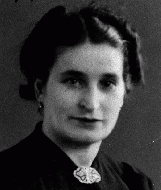
-
Hainewalde
ArticleThe SA established a protective custody camp at Hainewalde in March 1933. Well-known journalist and writer Axel Eggebrecht was among its early prisoners.
-
Liberation of Mauthausen
Timeline EventMay 5, 1945. On this date, US troops liberated Mauthausen concentration camp. Days before, a group of prisoners took control of Mauthausen.
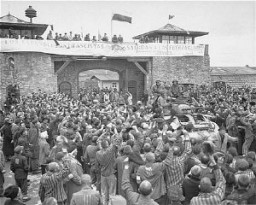
-
Boruch Golden's violin
ArtifactA childsize violin that belonged to Boruch Golden (Gordon), who was killed along with his mother and brother at the Ponary killing site in September 1943. Boruch was born in 1930, and was one of four children. His parents, Moshe and Basia Golden (Gordon), raised their family in Swieciany (Svencionys), Lithuania. After the German invasion of the Soviet Union in June 1941, the family was forced into the Swieciany ghetto. When that ghetto was later liquidated in 1943, the family was sent to the Vilna…
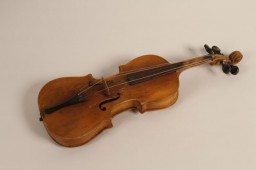
-
Railcar: Interior
ArtifactMany different kinds of railway cars were used for deportations. They varied in size and weight. The railway car on display in the United States Holocaust Memorial Museum's Permanent Exhibition is of just one type used. The dimensions of the railway car in the Museum's exhibition are as follows: Total length 31 feet 6 inches (9.6 meters); interior space for deportees 26 feet 2 inches (8 meters). Total height 14 feet (4.3 meters) from the bottom of the wheel to the highest point of the car; interior space…
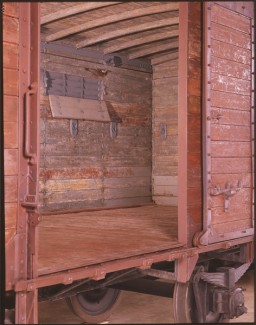
-
Valises by the railcar in the Museum's Permanent Exhibition
ArtifactMany different kinds of railway cars were used for deportations. They varied in size and weight. The railway car on display in the United States Holocaust Memorial Museum's Permanent Exhibition is of just one type used. The dimensions of the railway car in the Museum's exhibition are as follows: Total length 31 feet 6 inches (9.6 meters); interior space for deportees 26 feet 2 inches (8 meters). Total height 14 feet (4.3 meters) from the bottom of the wheel to the highest point of the car; interior space…

-
Beifeld album page titled "Mementos"
ArtifactCollage entitled: "Mementos from the Russian campaign," which includes a watercolor of Stalin with the caption: 'Russia a meeting place for foreigners 1942-43' (top); a commuter train ticket issued to military personnel who carried the special SAS [Hurry, Immediate, Urgent] draft notice (middle, right); a pseudo travel brochure cover entitled 'Spend your summer vacation in merry Russia' (bottom, left); and the original design for the cover of the labor company's journal entitled 'Hungarian Royal 109/13…
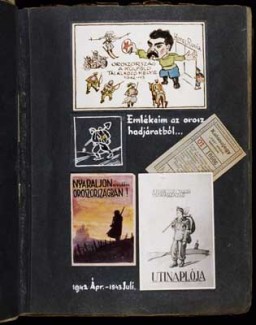
-
Lisa Nussbaum Derman and her family
PhotoLisa Nussbaum and her family. From left to right: Pola (sister), Herschel (father), Borushek (brother) Gittel (mother), and Lisa (about 13 years old in this photograph). Lisa's father exported geese to Germany for a living. Photograph taken in Raczki, Poland, ca. 1939. With the end of World War II and collapse of the Nazi regime, survivors of the Holocaust faced the daunting task of rebuilding their lives. With little in the way of financial resources and few, if any, surviving family members, most…
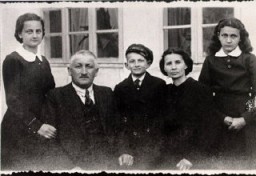
-
Western Desert Campaign: Egypt and Libya
ArticleLearn more about the Western Desert campaign during World War II in Egypt and Libya between 1940-1943.
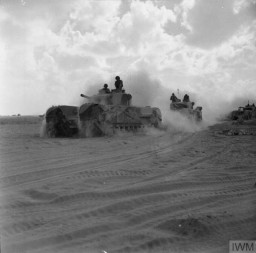
-
The Aftermath of the Holocaust: Effects on Survivors
ArticleSurvivors of the Holocaust faced huge obstacles in rebuilding their lives. Learn about the challenges they faced in the aftermath of the Holocaust.
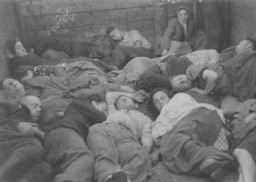
-
Budapest
ArticleNazi Germany occupied Hungary in March 1944. Learn about the experiences and fate of Jews in Budapest, Hungary's capital, before and after the occupation.

-
Gross-Rosen
ArticleLearn about the Gross-Rosen camp, including its establishment, prisoner population, subcamps, forced labor, and liberation.

-
Voyage of the St. Louis
ArticleThe voyage of the St. Louis, a German ocean liner, dramatically highlights the difficulties faced by many people trying to escape Nazi terror. Learn more.

-
Liberation: An Overview
ArticleLearn more about the end of Nazi tyranny in Europe and the liberation of camps and other sites of Nazi crimes. This article includes dates of liberation of some of the camps.

-
Subsequent Nuremberg Proceedings, Case #4: The Pohl Case
ArticleThe Pohl Case was Case #4 of 12 Subsequent Nuremberg Proceedings against leading German industrialists, military figures, SS perpetrators, and others.
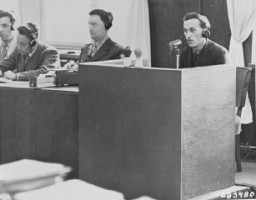
-
Edward R. Murrow
ArticleUS radio and TV journalist Edward R. Murrow reported live from London during the Blitz; he also broadcast the first eyewitness account of the liberation of Buchenwald.
-
Helen Baker Diary Entry
Timeline EventMarch 14, 1938. On this date, Helen Baker documented what she witnessed when Germany annexed Austria. Helen and her husband Ross Baker were Americans living in Vienna.
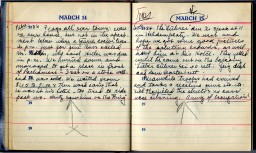
-
Embroidered matzah cover
ArtifactFollowing the Soviet occupation of Lithuania, the Lifszyc family began to search for ways to leave the country. David Lifszyc obtained a Curacao visa from the Dutch consulate. He also obtained an American visa because he was included on a list of distinguished rabbis submitted to the State Department by the Agudat Israel of America. After obtaining Soviet exit visas, the Lifszycs purchased tickets for Vladivostok on February 5, 1941. They started for Moscow, where they received Japanese transit visas. This…
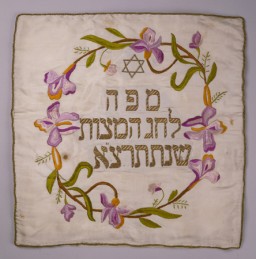
-
European Jewish population distribution, ca. 1933
MapJews have lived in Europe for more than two thousand years. The American Jewish Yearbook placed the total Jewish population of Europe at about 9.5 million in 1933. This number represented more than 60 percent of the world's Jewish population, which was estimated at 15.3 million. Most European Jews resided in eastern Europe, with about 5 1/2 million Jews living in Poland and the Soviet Union. Before the Nazi takeover of power in 1933, Europe had a dynamic and highly developed Jewish culture. In little more…

-
Jakub Lapides
ArticleYoung people's diaries bear witness to some of the most heartbreaking experiences of the Holocaust. Learn about the diary and experiences of Jakub Lapides.
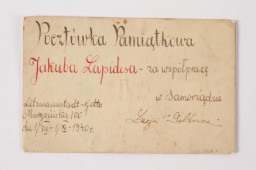
-
Theresienstadt: SS and Police Structure
ArticleLearn more about the unique SS and police structure of the Theresienstadt “camp-ghetto” during World War II.
-
Jewish Population of Europe in 1933: Population Data by Country
ArticleBefore the Nazis seized power in Germany in 1933, Europe had a richly diverse set of Jewish cultures. Learn more about the Jewish population of Europe.

-
The Enabling Act
ArticleThe Enabling Act of March 1933 allowed the Reich government to issue laws without the consent of Germany’s parliament. It laid the foundation for the Nazification of German society.

-
The 80th Infantry Division during World War II
ArticleThe 80th Infantry Division participated in major WWII campaigns and is recognized for liberating Buchenwald and the Ebensee subcamp of Mauthausen in 1945.
-
The "We Will Never Die" Pageant
Article"We Will Never Die" was a 1943 musical stage performance that raised awareness among Americans about the murder of European Jews. Learn more.

-
Stephen S. Wise
ArticleStephen Wise (1874–1949) was a prominent Jewish leader in the United States between 1933-1945. Learn more about his work during the Holocaust.

-
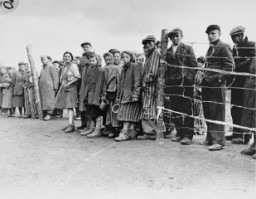
-
Auschwitz Camp Complex
ArticleAuschwitz was the largest camp established by the Germans. It was a complex of camps, including a concentration camp, killing center, and forced-labor camp.

-
Eleanor Roosevelt: The Early Years
ArticleShort biography of Eleanor Roosevelt, who would become the longest serving First Lady in US history.
-
Columbia-Haus
ArticleThe Columbia-Haus camp was one of the early camps established by the Nazi regime. It held primarily political detainees. Learn more about the history of the camp.
-
Franklin Delano Roosevelt
ArticleFranklin D. Roosevelt was 32nd president of the US. Learn about the domestic and international challenges FDR faced as president during World War II.
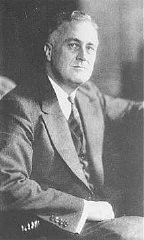
-
The Voyage of the St. Louis
Animated MapView an animated map describing the voyage of the St. Louis and the fate of its passengers, Jewish refugees from Nazi Germany in May-June, 1939.
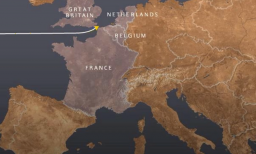
-
Neuengamme
ArticleIn 1938, the Nazis established Neuengamme concentration camp. Learn more about camp conditions, medical experiments, and liberation.

-
Joseph Goebbels
ArticleJoseph Goebbels, Nazi politician, propagandist, and radical antisemite, was Reich Minister for Propaganda and Public Enlightenment from 1933 until 1945.

-
The Krakow (Cracow) Ghetto during the Holocaust
ArticleThe Krakow ghetto in German-occupied Poland held over 15,000 Jews. Learn more about Krakow and the ghetto’s history during the Holocaust and WWII.

-
Zdziecioł (Zhetel)
ArticleThe Nazis occupied Zdziecioł (Zhetel), Poland in 1941. Learn more about the city and ghetto during World War II.
-
1943: Key Dates
ArticleExplore a timeline of key events during 1943 in the history of Nazi Germany, World War II, and the Holocaust.

-
Uckermark Youth Camp
ArticleThe Uckermark camp was one of the so-called youth protection camps that the Nazi regime established for young people who were alleged to have strayed from Nazi norms and ideals.
-
Bernhard Liebster
ID CardBernhard, who was from a religious Jewish family in the Polish town of Oswiecim, emigrated as a young man to Frankfurt, Germany. There he married Bertha Oppenheimer from the nearby town of Reichenbach. They settled in Reichenbach where they were one of 13 Jewish families. Bernhard worked as a shoemaker, and the couple raised three children. 1933-39: In a corner of his living room, Bernhard ran a small shop specializing in orthopedic shoes. Antisemitism was growing in Germany, but the townspeople of…
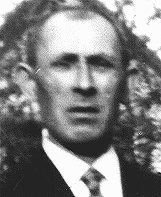
-
Robert Oelbermann
ID CardIn 1919 Robert and his brother Karl founded the Nerother Bund youth group in the Cologne region. Like other German youth groups, it aimed to bring youth closer to nature through camping and hiking. Homosexual relationships sometimes developed from the intense adolescent male camaraderie, and the Nerother Bund accepted these friendships, as did a number of German youth groups at the time. 1933-39: Soon after the Nazis took power in 1933, they dissolved all independent youth groups and urged the members to…
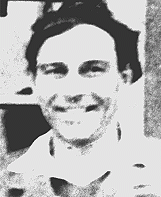
-
Frederick Dermer
ID CardFrederick was born to a Jewish family in the Austrian capital of Vienna. His father died when he was a baby, and he and his mother moved into an apartment with Frederick's widowed grandfather. As a young boy, Frederick attended a Viennese public school. 1933-39: Frederick was a rambunctious child. Once, when his grandfather was baby-sitting, Frederick used a silk lampshade as a "parachute," and jumped from the top of the wardrobe closet. That was the last time Frederick's grandfather would baby-sit.…

-
Beads used by a Dutch Jewish girl in hiding
ArtifactThese tiny black, white, gold, and clear glass beads were used by Rachel “Chelly” de Groot from November 1942 to April 1944 and recovered by her brother Louis after the war. Chelly used the beads to make handicrafts. On November 16, 1942, Chelly, then 15, Louis, 13, and their parents Meijer and Sophia left Arnhem and went into hiding after the Dutch police warned them of a raid. Meijer and Sophia hid in Amsterdam while Chelly and Louis moved around to different locations. In summer or fall 1943,…
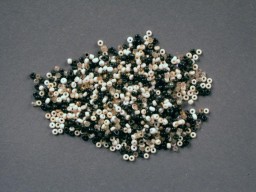
-
Maria Nemeth
ID CardMaria's parents lived in Szentes, a town in southeastern Hungary, located 30 miles from the city of Szeged. Her mother, Barbara, was born in the neighboring town of Hodmezovasarhely, but moved to Szentes when she married. Maria's father was a dentist. 1933-39: Maria was born in 1932. In 1937 her mother took in a young Austrian woman who lived with the family and helped Maria learn German. 1940-44: In March 1944 German troops occupied Hungary. Members of the Hungarian fascist party, Arrow Cross,…

-
Eva Heyman
ID CardThe only child of a cosmopolitan Hungarian Jewish couple, Eva grew up in a city on the border between Romania and Hungary. Nearly one-fifth of the city's population was Jewish. Eva was a small child when her parents, Agi and Bela, divorced, and she went to live with her grandparents. 1933-39: After the divorce, Eva saw little of her mother, who remarried and moved to Budapest. She also rarely saw her father, who lived on the other side of the city. Eva lived with her grandmother and grandfather near the…
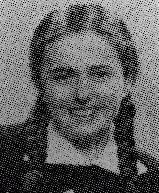
-
Henry Morgenthau Jr.
ArticleHenry Morgenthau Jr had a key role in creating and operating the War Refugee Board, a government agency tasked with rescuing and providing relief for Jews during the Holocaust.
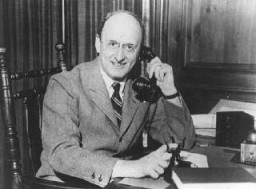
-
Frances Perkins
ArticleFrances Perkins was FDR's secretary of labor. Learn about her role in the rescue of European Jews whose lives were threatened by the Nazi regime.

